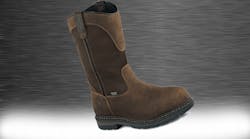When it comes to protective footwear on the job, no single work boot meets the needs of all employees. Every jobsite or work environment is different, and different occupations require distinct, purpose-built features. Whether you purchase PPE directly for employees, offer them vouchers or facilitate on-site mobile truck visits, it is imperative that you coach your workers on the proper foot protection for their specific working conditions.
To help guide you and your team to the right footwear, here are 14 common occupations and some key features to look for in work boots for each:
Bricklayers/Masons. Look for 6-to-8-inch lace-up boots for ankle protection and support and cushioned outsoles/footbeds for comfort on concrete. Select boots with oil-tanned leathers for resistance to lime and calcium.
Carpenters. For these workers, seek boots featuring a welt outsole with shank and defined heel for climbing ladders. Choose boots with waterproof leather for outdoor work.
Plaster/Drywall Contractors. These specialists often wear boots with wedge outsoles for traction. You may extend the life of these boots with toe armor or boot bumpers. Choose oil-tanned leathers for resistance to lime and calcium.
Construction Workers. These craftsmen need tight-grain, oil-tanned leather for resistance to hydraulic fluid and wet/dry cycles outdoors. Select harder soles for rough duty, with proper tread for uneven terrain.
HVAC Professionals. Like construction workers, HVAC technicians perform at multiple sites and in varying conditions throughout the day. Look for boots that are waterproof for outdoor conditions with cushioned outsoles/footbeds for comfort on concrete. Also, choose boots with flat outsoles that don’t track dirt when going into and out of homes.
Farmers/Ranchers. These individuals should seek pull-on or lace-up boots for ankle protection and support. Look for oil-tanned, waterproof leathers for exposure to wetness and fertilizers. Farmers and ranchers working in rough and tumble environments should select boots with a more aggressive tread for traction.
Truck Drivers. Choose boots with lighter weight leather for flexibility and comfort while driving, and harder soles that wear better on metal steps and asphalt. Cushioned outsoles/footbeds reduce shock absorption.
Electricians. Electrical hazard protection is, of course, a must. Beyond that, electricians should look for boots with a welt sole and shank, and a defined heel for climbing ladders. Cushioned outsoles/footbeds add comfort on concrete.
Landscapers. Oil-tanned, waterproof leathers stand up to exposure to fertilizers. Landscapers should choose boots with strong heel counters to reduce walkover in wet, uneven terrain. Look for flat tread, wedge outsoles that won’t tear up new installations.
Mechanics and Machinists. Select boots or shoes with oil/slip-resistant urethane outsoles for traction, and direct-attach or sealed-welt construction for resistance to petroleum products.
Well Drillers. Consider logger-style lace-up boots with strong waterproof leather for wet conditions. Hard outsoles with deep cleats are ideal for grip in loose soil.
Plumbers. These specialists should seek boots with waterproof leathers, supporting shank and defined heels for climbing ladders. Flat soles pick up less dirt and are ideal for going into and out of homes.
Pipefitters. Like plumbers, pipefitters should consider waterproof boots with shank and defined heels for support on ladders. In addition, they also may prefer heat-resistant outsoles for job environments with welding and other high-heat hazards.
Project Managers. Workers who balance their time between a desk and a jobsite should choose footwear with full grain leather for flexibility and durability.
The Modern Craftsman
Today’s modern craftsmen are skilled tradespeople who want it all: performance, durability, style and value. They’re looking for younger, faster, more athletic-type styling because many of them have grown up wearing athletic footwear such as tennis, skateboarding or basketball shoes.
Now that they are on the job, these workers want work boots and shoes that reflect that athletic footwear tradition – with no break-in period. Safety and jobsite leaders should keep this in mind because a comfortable work force makes for a productive workplace.
Safety First
No matter what their trade, make sure your workers wear boots or shoes that meet or exceed applicable safety standards. Two key North American groups maintain rigorous safety standards for work footwear that can help guide you and your team with confidence to the right boots for the job. The American Society for Testing and Materials (ASTM) specifies the standard of performance for protective safety toe footwear at http://www.astm.org/Standards/F2413.htm, and the Canadian Standards Association’s (CSA) standards for foot protection can be found at http://www.csa-international.org/product_areas/occ_health_and_sports_safety/footwear/.
Check boot packaging or talk with your footwear retailer to find boots that meet these standards and have specific features for the job at hand. After all, a work force is only as strong as the feet upon which it stands.
Maurice McClurg is work and hunt marketing manager for Red Wing Shoe Co. Learn more at http://www.redwingshoes.com.
